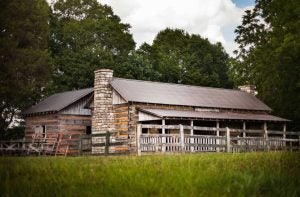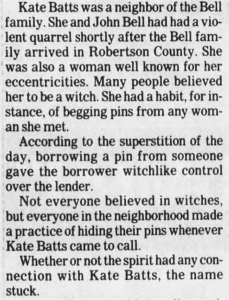This article is part of an AGDAILY series on the history and lore of haunted farm locations across the United States.
Farms and farmhouses seem to often be the epicenter of scary tales and haunts. Having grown up in a farming family and an old farmhouse myself, it’s easy to see why.
The house and barn are often passed down from generation to generation, and we try our hardest to preserve the work of our relatives and keep the home original — creaky stairs and all. Not to mention the fact that many farmers feel that they live to farm and often die doing what they love the most. In fact, there are multiple farms I know where the original owners are buried on the property.
This creates the perfect scene for spooks and scares, and those who love scary stories and horror movies are always excited to listen to haunted farm stories. If you love these spooky tales, this one is a good one to know!
In Adams, Tennessee, less than an hour drive from Nashville, lies the Bell Witch Cave farm.
Legend says that in 1804, John and Lucy Bell and their eight kids moved from North Carolina to Adams Tennessee, where they bought a 320-acre farm. All stories say that the family lived there happily for over a decade, but then in 1817 spooky things started happening.
Sure farm animals can get a little crazy sometimes, but the Bell family claims to have seen dogs with rabbit heads and other strange creatures running around the farm. Shortly after these appearances, the family started feeling as if they were being tormented by something in their home.

John Bell and his youngest daughter, Betsy, took the brunt of the haunting, claiming to be physically tormented and even having the feelings of choking or of a stick being pushed through their neck. While John and Betsy were left bruised and battered, the rest of the family also had to bear spooky torments like sounds of chains being dragged throughout the house, hearing a voice in their house, and feeling that they were prisoners in their little Tennessee farm.
Nobody is sure as to why the Bell family was being tortured, or by whom. The two prevailing theories is that the tormentor, who is commonly known as the Bell Witch, was an Native American woman buried on the property, and her bones were found and scattered by the Bell boys. Or that she is the supposed witch who was previously known as Kate Batts, a neighbor of the Bell’s new property. She was said to have been a crazy woman with little resources. When purchasing the land from the Batts family, allegedly John Bell tricked Kate into giving him a better deal on her land than Kate had bargained for.
What makes this theory believable is that many people reported that when going to town, Kate was known to ask other women to spare her a pin. Back when women went on trial for being witches, it was commonly known superstition that if a woman had your sewing pin, that gave her a voodoo-like control of you. Kate Batts didn’t have much money, so the people who felt bad and gave her a pin reportedly later regretted it.

Only three years after the strange farm animals appeared and bad things started happening in the Bell home, John Bell was the first man to ever have his death certificate read “supernatural causes” as the cause of death.
Although some people believe it’s a bluff, John was poisoned in his sleep after years of the Bell Witch promising to be the one who ended his life.
Check out the following clip to see a Ghost Adventures recap of their time on the Bell family farm. And the next time you buy a little land, think about who your neighbors are, or maybe who is buried on the property.
Elizabeth Maslyn is a born-and-raised dairy farmer from Upstate New York. Her passion for agriculture has driven her to share the stories of farmers with all consumers, and promote agriculture in everything she does. She works hard to increase food literacy in her community, and wants to share the stories of her local farmers.



